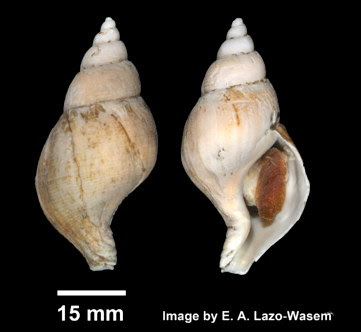Hairy colus Colus pubescens, copyright E. A. Lazo-Wasem.
Colus has been used as the basis of a family group name at many levels of whelk classification, whether it be Colidae, Colinae or Colini. The gastropod classification laid out by Bouchet et al. (2017) recognised 'Colini' as a diverse tribe within the main whelk family Buccinidae, including a range of cold-water taxa. However, a more recent phylogenetic analysis of the buccinoids by Kantor et al. (2021) found Bouchet et al.'s concept of Colini to be polyphyletic, placing the type genus Colus outside what the called the 'core Buccinoidea'. As such, they raised Colidae to the status of a separate family and restricted it to just two genera, Colus and Turrisipho.
In this restricted form, the Colidae are thin-shelled, medium-sized to large whelks with the largest having shells up to twenty centimetres in length. The shells are fusiform to ovate in shape with a more or less elongate siphonal canal and covered by a brown periostracum. Axial sculpture is absent; spiral sculpture is expressed as more or less prominent cords. The aperture is closed with a operculum bearing a terminal nucleus. The animal has a more or less long proboscis. The radula bears three teeth per row; the middle tooth has a more or less square base and one to three cusps, with the middle cusp the largest, whereas the lateral teeth bear three hooked cusps with the outermost cusp significantly larger than the other two. None of these features, it should be noted, is entirely unique to the Colidae (Kantor et al. 2021).
Members of the Colidae are found in the Arctic and northern Atlantic Oceans, from subtidal to bathyal depths. Because they are not targeted commercially, the life habits of colids have not been well studied. However, what we do know indicates that they are likely predators on other invertebrates (Kosyan 2007). The long proboscis of most species is probably used to pull infaunal animals such as amphipods and bivalves out of their burrows. Colids have well-developed salivary glands and it is possible that these may produce toxins as found in other neogastropods. They do not have anything like the elaborate venom delivery setups like those found in the conoids, but even a little dose of toxic saliva helps to subdue a struggling crustacean.
REFERENCES
Bouchet, P., J.-P. Rocroi, B. Hausdorf, A. Kaim, Y. Kano, A. Nützel, P. Parkhaev, M. Schrödl & E. E. Strong. 2017. Revised classification, nomenclator and typification of gastropod and monoplacophoran families. Malacologia 61 (1–2): 1–526.
Kantor, Y. I., A. E. Fedosov, A. R. Kosyan, N. Puillandre, P. A. Sorokin, Y. Kano, R. Clark & P. Bouchet. In press 2021. Molecular phylogeny and revised classification of the Buccinoidea (Neogastropoda). Zoological Journal of the Linnean Society.
Kosyan, A. R. 2007. Morphological features, ecology, and distribution of poorly studied molluscan genera of the Colinae subfamily (Gastropoda, Buccinidae) from the far eastern seas of Russia. Oceanology 47 (4): 531–536.


















No comments:
Post a Comment
Markup Key:
- <b>bold</b> = bold
- <i>italic</i> = italic
- <a href="http://www.fieldofscience.com/">FoS</a> = FoS